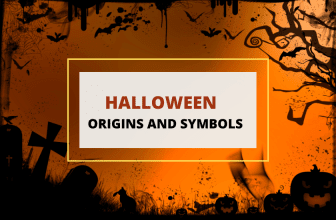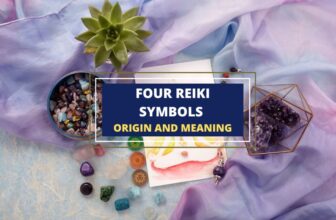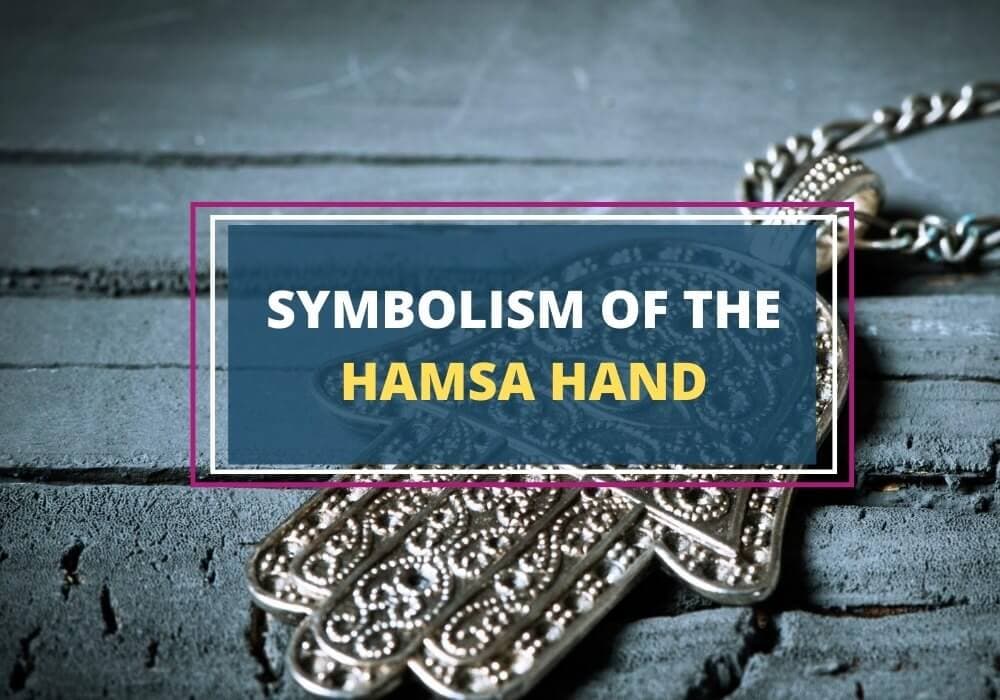
Table of Contents
If you take a trip to the Middle East or North Africa, chances are you’ll spot a lot of people wearing the Hand of Fatima, also known as Hamsa. You may even hear people mutter “Hamsa, Hamsa, Hamsa, tfu, tfu, tfu”, similar to the English phrase touch wood.
The Hamsa is that rare symbol that makes an appearance in all the world’s major religions, including Hinduism, Buddhism, Judaism, Christianity and Islam. Each of these religions adopted the Hamsa and gave it their own interpretation.
But where does the Hamsa Hand come from and what is its original meaning? Let’s begin by looking at the design of the Hamsa, what it represents and how it’s used in the modern era.
What is the Hamsa Hand?
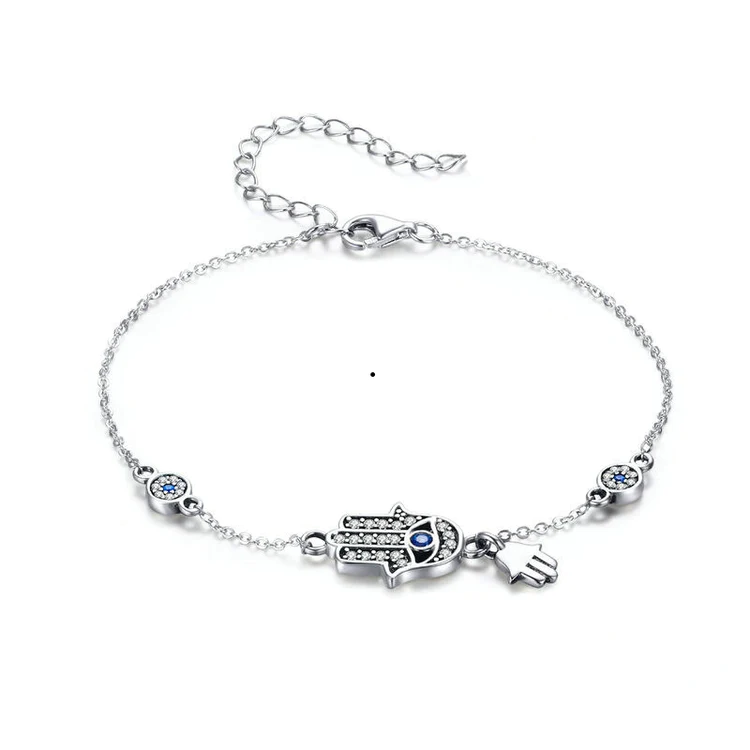
First of all, let’s note that the Hamsa is known by many names. This is because it’s an important symbol in almost every major religion. Here are some of its names.
- Hamsa: A transliteration of the Arabic “Jamsa” or “Khamsah” meaning five
- Hand of God: A general name
- Hand of Fatima: After Fatima, the daughter of the Islamic prophet
- Hand of Miriam: After Miriam, the sister of Aaron and Moses of Jewish faith
- Hand of Mother Mary: After Mary, the mother of Jesus in Christian beliefs
- Hamesh: Meaning 5 in Hebrew
- It’s also known by the variations Humes Hand, Khamesh and Khamsa
The Hamsa Hand is one of the oldest symbols in history, dating back several thousand of years. Scholars believe it pre-dates all major religions, many of which later adapted the symbol to represent some aspect of the religion. The Hamsa may have originated in Mesopotamia and Carthage, where it was used as an amulet to repel the evil eye, a concept that existed in a wide range of cultures. From there, it spread geographically to become a globally recognized image, but it was popular in the Middle East and North Africa.
The Hamsa symbol is often depicted as a symmetrical hand, with fingers pressed close together, either facing upwards or downwards. Sometimes, it features an eye at the center of the palm. This is the nazar boncugu, believed to repel the evil eye.
Which Way Does the Hamsa Hand Point?
- A Hamsa facing downwards symbolizes abundance and prosperity, inviting good things to come into your life. An upside-down Hamsa also is seen as a blessing for fertility as well as a means of receiving answered prayers. Generally, the fingers are close together when facing down.
- A Hamsa facing upwards acts as a talisman against evil and any malicious intent. Additionally, it acts as a shield against any negative thoughts and feelings you may have about yourself and others, including greed, jealousy, and hatred. The fingers are sometimes spread apart, symbolizing the warding off of evil.
Hamsa Hand Symbolism
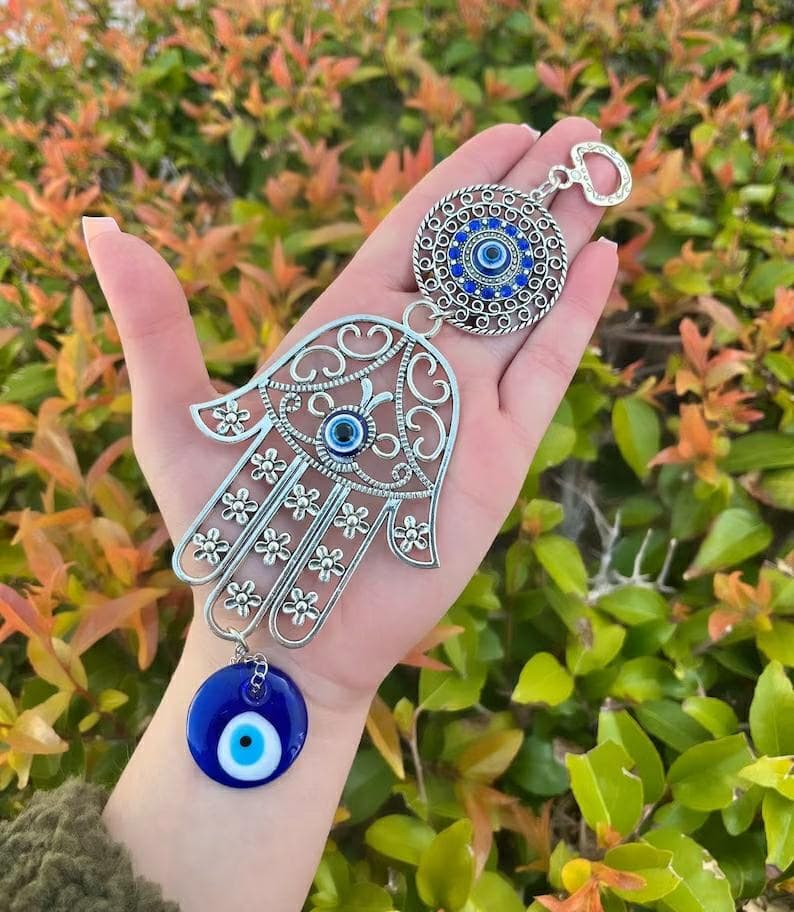
In general, the Hamsa hand is a symbol of protection, warding off evil and keeping the user safe. It acts as a good luck charm. However, like any other symbol, it should be no surprise that the Hand of Fatima has acquired new meanings as it was integrated into different religions and beliefs. Outside of religious circles, the Hand of Fatima has gained a more general understanding.
1. Hamsa in Christianity
Within the Catholic denomination, there is a loose linking of the Hamsa Hand with the Virgin Mary, who represents strength, compassion and the feminine. It also reflects the concept of Mary exalted above all else and as a benevolent mother towards all. In the wider Christian community, the eye in the center is replaced with the Christian symbol of the fish, the vesica piscis. It is a symbol of protection against those who wish to do you harm.
2. Hamsa in Hinduism and Buddhism
In these Eastern faiths, the Hamsa is often taken to represent the chakras (the energy centers that run along the spine) and the energy that flows between these centers. The Hamsa is also connected to the mudras, or spiritual hand gestures. Each of the five fingers has an energy, and the five particular mudras associated with the Hamsa are:
- Thumb: The solar plexus chakra and fire element
- Forefinger: The heart chakra and air
- Middle finger: The throat chakra and ethereal elements
- Ring finger: The root chakra and earth element
- Pinkie finger: The sacral chakra and water.
3. Hamsa Hand in Judaism
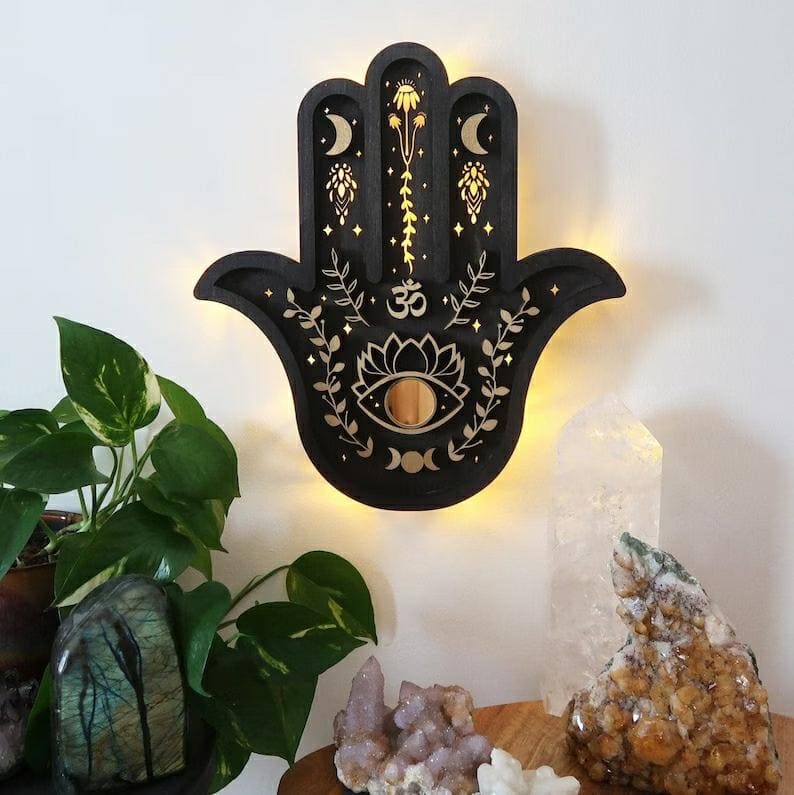
In Judaism, the Hamsa’s value comes from its connection to the number 5, which has holy associations in the faith. Five is the number of holy books in the Torah, it’s one of God’s names, and it also reminds the wearer to use their five senses to praise God.
4. Hamsa in Islam
Within the Muslim community, the Hamsa Hand takes on the same meaning as that found in other cultures in the Middle East. That is, the Hand of Fatima is an amulet to ward off the evil eye and protect the wearer from curses. However, the five fingers of the Hand of Fatima can also represent the five pillars of Islam:
- Faith and the belief that there is only one God and one Prophet
- Prayer which is obligatory
- Alms which is compulsory giving to help others
- Fasting during the month of Ramada to enhance one’s spirituality and connection to God
- Pilgrimage to Mecca
5. Generalised Interpretation
Because of the Hamsa’s connection with numerous religions, it can be seen as a symbol of unity. Its connection to female figures emphasizes it as a symbol of femininity and compassion. Because the Hamsa had been around before the major religions, it can be considered a pagan or spiritual symbol as well. It’s also a representation of the unity between male and female energies, which come together to bring harmony, balance and enlightenment.
Hamsa Hand in Jewelry and Fashion
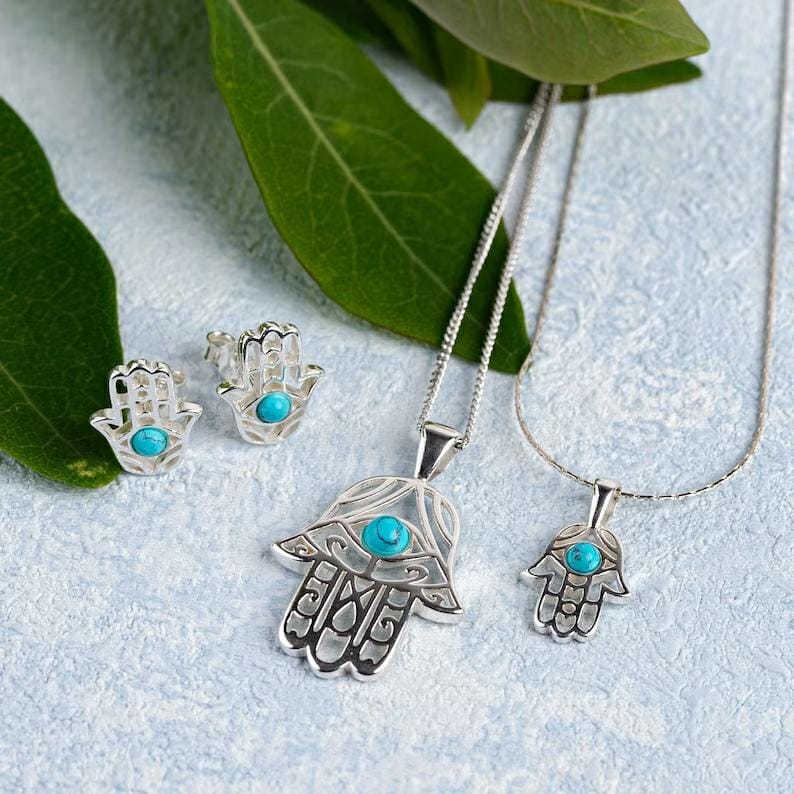
The Hamsa hand is popular in jewelry and fashion, because not only does it look stylish, but it also holds purported protective powers. Popular Hamsa jewelry includes pendants, as they can be kept close and seen when you look down. It’s also often incorporated into bracelet designs, again, because it can be seen on your hand easily.
Hamsa charms are another good way to keep the symbol close. These can be hung in cars, kept in the workplace, by windows, or doorways. It’s also a common tattoo symbol, typically combined with the Nazar boncugu.
Is It Culturally Appropriate to Wear the Hamsa Hand?
If you’re worried that wearing the Hamsa Hand is cultural appropriation, it’s important to note that the symbol can’t be claimed by any single culture or religious group. While the symbol does carry religious connotations, it’s also a general protection symbol.
All things considered, the Hamsa offers many symbolic interpretations, and it would be unfair and wrong for any group to lay claim to it. However, it’s a good idea to understand the symbolism behind the image if you decide to have it inked on your body or featured in your jewelry, as a sign of respect.
Hamsa Hand FAQs
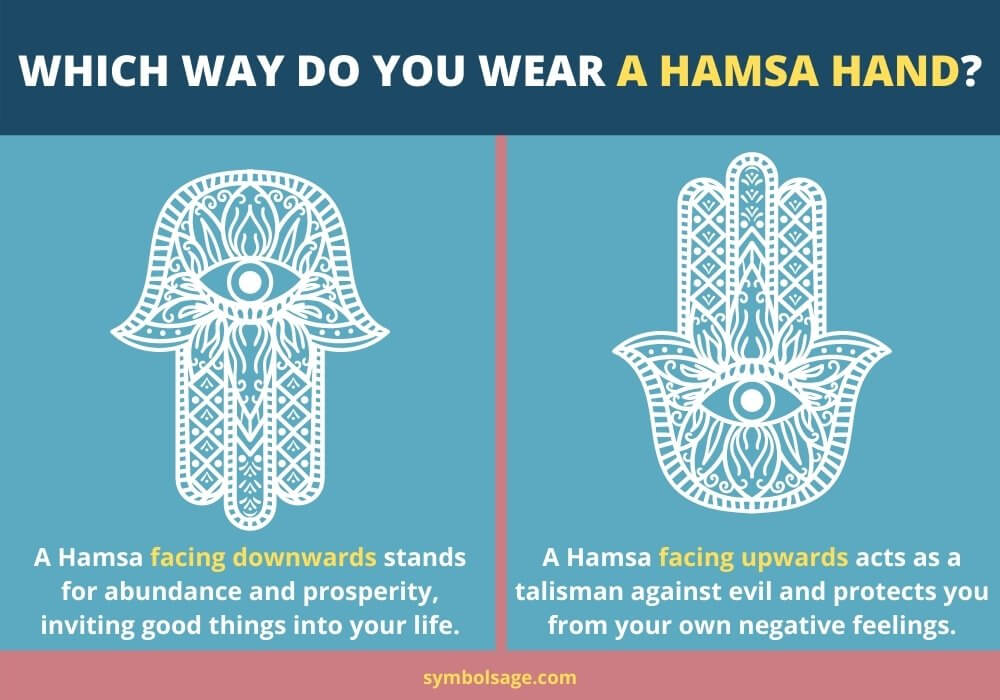
While the evil eye performs the sole function of repealing the evil eyes of others; the Hamsa hands radiate positivity and bring forth fortune while also warding off bad energy.
An Israelite tomb with an inscription like the Hamsa Hand was found as far back as the 8th century. Hence, its origin can be traced to ancient Carthage (now Tunisia) and North Africa. The Hamsa hand has also been found in Mesopotamia (Kuwait and Iraq) and other Western countries.
The Hamsa Hand symbolizes happiness, good health, fortune, good luck, and fruitfulness and has an eye grafted on its palm to repeal negativity and bad wishes. Religiously, it can mean different things.
The Hamsa hand derives its meaning from the Arabic word “Hamesh” which means “five”; hence, it has five fingers. In Judaism, these fingers are used to refer to the five books of the Torah: Genesis, Exodus, Leviticus, Numbers, and Deuteronomy.
Yes. In Islam, it was renamed the “Hand of Fatima” after the Prophet’s daughter (Fatima), who exhibited patience, faithfulness, and abundance in her lifetime.
When the palm faces upward, it shows that it is against evil. When it faces down, it is usually fused, and it attracts good luck, abundance, kindness, fertility, and friendship. Either way, it spells goodness.
This would depend on your faith. While some Christians regard the Hamsa as the hand of Holy Mother Mary and believe in its ability to invoke her (Mother Mary’s) protection, others frown at the Hamsa as a pagan symbol.
Not all Hamsas are fortified. Some people wear it as an expression of their spirituality while others put it on with belief in its idea or only as a jewelry piece.
Some Hamsas do not have an eye. However, for Hamsas that do, the eye is present to protect the wearer from the evil eye of others. Therefore, it should also not be mistaken as the evil eye.
The Hamsa hand has grown popular in the Western world. It can be seen worn by celebrities or hung on the wall as art. It is not a myth but a symbol across many religions and cultures.
Wrapping Up
Overall, the Hamsa Hand continues to be a universally used and well-regarded symbol. It’s multi-layered and complex in its many meanings, but at its heart, the Hamsa symbol represents protection from evil. Even today, many choose to keep the Hamsa Hand close as a symbol of protection and good luck.
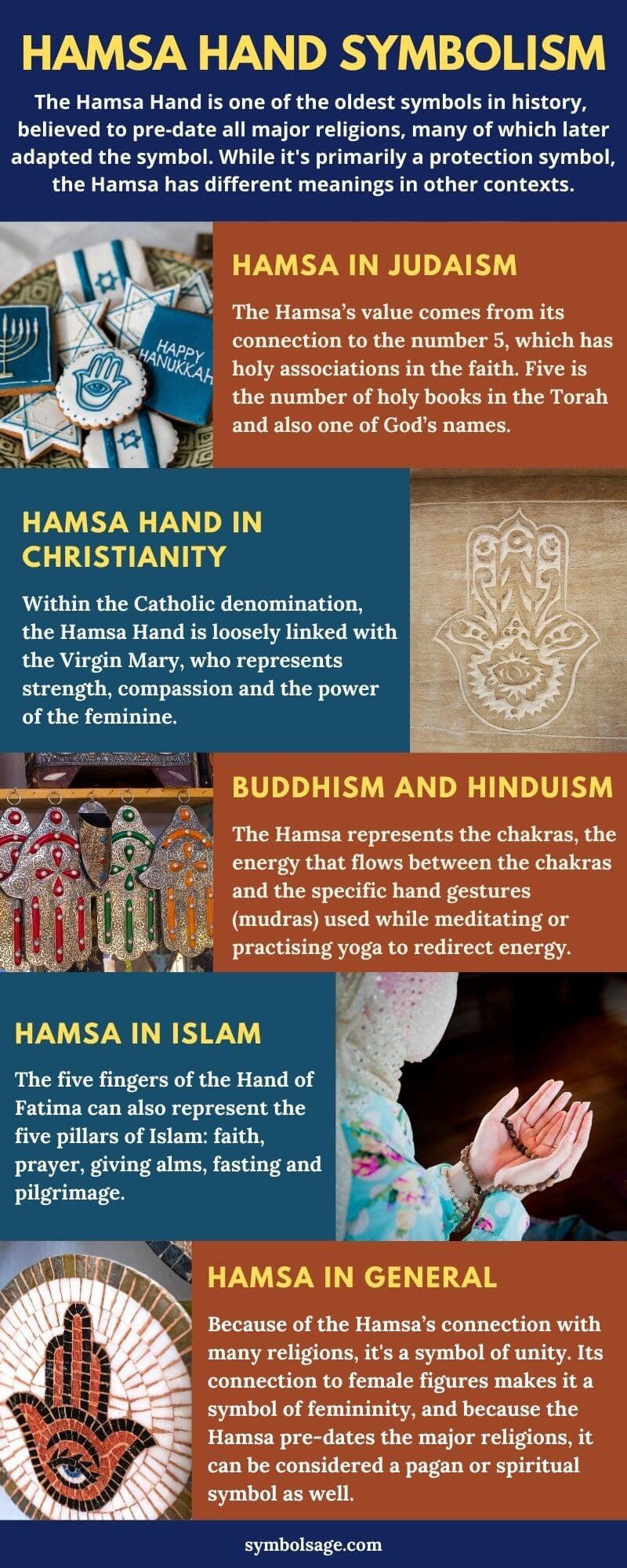
Related Articles
What Is the Eye of Providence — History and Meaning
14 Popular Jewish Symbols and Why They’re Important
Symbols Used in Jewelry – And What They Mean
20 Powerful Symbols of Positive Energy
Top 10 Symbols of Evil and What They Mean






